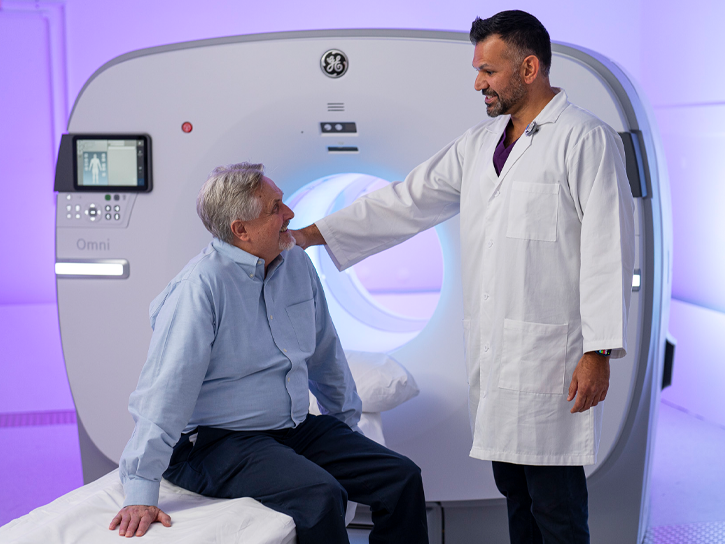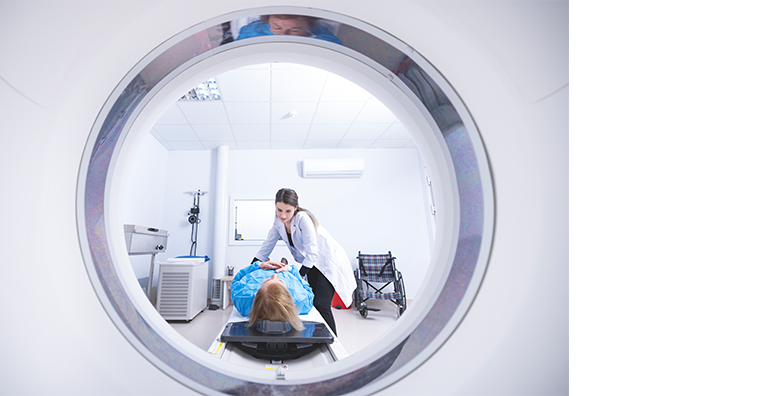With over 17 million new cancer cases diagnosed per year worldwide and nearly ten million cancer deaths in 2020 alone, cancer remains one of the most urgent health concerns globally1, 2. New therapies to address these cancers are progressing through clinical trials and coming to market, and theranostics has become a compelling and rapidly developing therapy option
The recent introduction and rapid adoption of PLUVICTO® for metastatic castration-resistant prostate cancer (mCRPC) has ushered in a new era of theranostics care. Other potential applications for theranostics are emerging, spanning oncology, neurology, and cardiology diseases. Theranostics is creating new and unprecedented hope for patients.
Theranostics defined
Theranostics is essentially the coupling of diagnostic and therapeutic radioactive tools related to the same specific molecular targets, enabling more accurate patient selection, prediction of treatment response and tissue toxicity, and response evaluation, with the goal of better outcomes.3
Understanding the Theranostics landscape
While this wave of novel treatment options is promising, it presents new challenges for healthcare providers, including having baseline knowledge of the therapy’s clinical applications, benefits, and risks. Managing the human side of theranostics requires providers to masterfully address awareness, appropriateness, access, and efficacy on behalf of their patients.
Awareness
Is the patient’s clinical team aware of Theranostics treatment options?
Theranostic options work differently than existing chemotherapy, immunotherapy, and external radiation options. While thyroid treatment with radioactive iodine (RAI) has been established for decades3, more recent applications may not be widely or deeply understood yet by all oncology providers. New and expanding therapy awareness is crucial to navigate patients to appropriate facilities.
Appropriateness
Is Theranostics an appropriate treatment option for the patient?
Oncology treatments are tailored to the patient and the patient’s individual cancer expression; theranostics are no exception. Indications for use are heavily based on cancer type, progression, previous therapies attempted, radioligand diagnostics, and other clinical criteria. As the treatments, indications, and clinical trials continuously evolve, keeping pace with this knowledge base is challenging.
Access
Does the patient have access to the therapy they need?
Once a patient has been matched with a therapy, questions around access and availability surface. Which healthcare facility offers the specific radiopharmaceutical needed? Will that facility be able to access the radiopharmaceutical needed? How far is the facility from the patient’s home? Can the patient realistically adhere to the radiation safety protocols required to keep their loved ones and the general public safe? Will insurance cover diagnostic tests and therapy?
Efficacy
Will the therapy be effective for the patient?
Prior to and throughout the treatment cycle, the most important question is whether the treatment will markedly impact the cancer and improve the patient’s length and quality of life. Currently, most theranostics treatments follow a standardized regimen with the same dose provided at the same interval for every patient.
We believe there is significant potential to unlock more personalized care in this therapeutic discipline. With rapid advancements, theranostics may potentially help clinicians provide more customized management for different types of cancers, improve patient selection, enable prediction of treatment response, and determine patients’ prognoses.
Finding the right people to chart a path forward
For organizations that want to establish a new theranostics service or program, start with building your team. This group of people play a crucial role in addressing Awareness, Appropriateness, Access, and Efficacy of theranostics care and should be continually engaged and educated throughout the program development process and beyond.
When building anew, clinical and administrative leaders should consider members of their program “coalition” to include:
-
Champions who will shepherd the necessary research, business case development, and program strategy on behalf of the organization.
-
Clinical thought leaders in the organization who will keep pace with emerging research, clinical trial results, approvals, and expansions and create pathways and mechanisms to spread this information.
-
Treating and referring providers who need to be aware of leading and evolving care practices, especially given the anticipated pace of theranostics advancements.
-
Community providers who should be knowledgeable about the care pathway as they manage and monitor any comorbidities and complications for the patient.
-
Trusted peers, researchers, and industry partners who can ease and accelerate the journey through best practice sharing and program pitfalls to avoid.
With the right team in place, program leaders can stay abreast of developments and decisions that impact program design and delivery, and in turn make nimble adjustments to their program with the ultimate goal of providing the best theranostics care possible.
As theranostics continues to prove its viability as a live-saving treatment option, more and more healthcare leaders are exploring program design models that are right for their organizations, bringing Tiny Signs of Hope to their patients and communities. More than a novel approach, the field of theranostics is approaching Paul Ehrlich’s originally proposed magic bullet, capable of bringing hope and having a profound effect on the lives of millions of patients.3
For more information on program models and design considerations, read Part 2: The Principles of Theranostics Program Design
REFERENCES
- https://www.cancer.org/content/dam/cancer-org/research/cancer-facts-and-statistics/global-cancer-facts-and-figures/global-cancer-facts-and-figures-4th-edition.pdf
- https://www.who.int/news-room/fact-sheets/detail/cancer
- “Theranostics in Nuclear Medicine: Emerging and Re-emerging Integrated Imaging and Therapies in the Era of Precision Oncology”, RadioGraphics, Vol 40, Number 6, October Special Issue 2020


